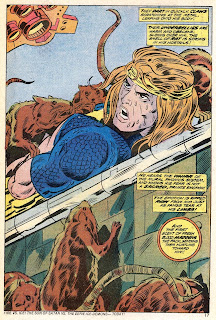4 / 5 Stars
I am NOT making up this synopsis:
Harold Pierce is a mental patient, a man disfigured from burns acquired when, as a child, he was caught in a house fire (he carelessly started the fire while torturing crane flies........ by dropping lit matches into the jar holding them).
As the book opens, Harold is being released from an asylum, and forced to make his own way in the world. He finds employment as an aide at Fairvale Hospital in the little town of Exham in northern Britain. One of his assignments is to dispose of the corpses of aborted fetuses by placing them in the hospital furnace. However, this action makes Harold so distraught that he smuggles the corpses out from the hospital and buries them in makeshift graves near his small cottage (!).
One night, a severe storm hits the area and the ground over the graves is struck by bolt of lightning. The corpses of the fetuses are revived and, using a powerful telepathic ability, they command Harold to dig them up, and shelter them in the dank cupboard below the sink in his cottage (!).
It becomes apparent that the zombie fetuses (the Spawn of the book's title) need human blood to sustain them......and an increasingly deranged Harold is forced to carry out the wishes of these demonic creatures.
To make matters worse, a lunatic named Paul Harvey (!) has escaped from the Exham mental hospital and is loose in the countryside, having armed himself with a rusty scythe. When headless corpses start turning up in the vicinity of Exham, it looks like Harvey is on the prowl....and when he meets up with Harold and the Spawn, the body count can only get worse....
'Spawn' (Leisure Books, 1983, 367 pp.) features a great cover illustration of a truly malevolent-looking fetus gazing at the reader. Unfortunately, the artist is uncredited.
I remember seeing Shaun Hutson's paperback novels on the shelves back in the mid 80s; 'Slugs' stuck in my memory. His US publisher was Leisure Books, today a significant source of many horror and mystery titles.
But......... back in the 80s there was a rather low-class, pulp-fiction air to Leisure Books and its releases (at least, as far as more mainstream publishers were concerned).
Authors like Hutson were not granted approving cover blurbs from genre heavyweights like Steven King or Peter Straub. In fact, there was some degree of enmity between Ramsey Campbell- the grand old man of British Horror - and Hutson. And, needless to say, Hutson and other Leisure authors were not included in high-profile collections of the era, like DAW's The Year's Best Horror Stories or any of the other anthologies of the 80s (Whispers, Shadows, Prime Evil, etc.).
This was unfortunate, since Hutson was one of the premiere British Splatterpunk authors, and a descendent of a literary line first founded by Colin Wilson in the 60s, then carried on by James Herbert in the 70s, before Hutson (and Clive Barker) sustained the genre through the 80s.
Hutson's books are unashamedly gruesome and transgressive, and may be considered trash by some readers. The various literary contrivances that constitute 'quality' fiction writing may not make an appearance. But Hutson's books often have an undercurrent of sly humor, as if a smiling Hutson is asking the reader to join him in offending moral sensibilities and insulting the purveyors of 'quiet' horror.
In my opinion, Hutson's novels are more genuine examples of the genre than most of the mannered, plodding works issued by Campbell, Straub, and King. Anyone looking for an offbeat, original horror tale will find that 'Spawn' fits the bill.
This was unfortunate, since Hutson was one of the premiere British Splatterpunk authors, and a descendent of a literary line first founded by Colin Wilson in the 60s, then carried on by James Herbert in the 70s, before Hutson (and Clive Barker) sustained the genre through the 80s.
Hutson's books are unashamedly gruesome and transgressive, and may be considered trash by some readers. The various literary contrivances that constitute 'quality' fiction writing may not make an appearance. But Hutson's books often have an undercurrent of sly humor, as if a smiling Hutson is asking the reader to join him in offending moral sensibilities and insulting the purveyors of 'quiet' horror.
In my opinion, Hutson's novels are more genuine examples of the genre than most of the mannered, plodding works issued by Campbell, Straub, and King. Anyone looking for an offbeat, original horror tale will find that 'Spawn' fits the bill.






















































.jpg)
















